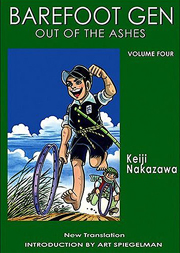Jeffrey Brown and The Holy Consumption: From Chicago to Paris
 With only a matter of hours until much of the ComicMix team heads out to Chicago for this year’s show, it’s only right to post a story or two with ties to the ol’ Windy City.
With only a matter of hours until much of the ComicMix team heads out to Chicago for this year’s show, it’s only right to post a story or two with ties to the ol’ Windy City.
From June 21 to July 26, several members of the Chicago-area comic creators collective known as "The Holy Consumption" will have their art featured at Galerie Anne Barrault in Paris, France. Among the creators whose work is currently on display are Paul Hornschemeier (Mother, Come Home), Anders Nilsen (Dogs and Water) and Jeffrey Brown, the author of one of my favorite minicomic collections, I Am Going To Be Small.
The exhibit, titled "Midwest," promises to explore "the American Midwest, a huge, flat, agricultural area around Chicago, stretching over several states, swept by the winds, dotted with the Great Lakes."
IVY Paris News recently spoke with Brown about the exhibit and the notion of being an "artist" instead of a cartoonist:
Traditionally in comics, the final published book has been the ‘art’ – the drawings are just in service of the published version. In art school, I had the idea of the original drawings being the final work, imagining the book as it’s own final result. I think there’s an intimacy to the real, tangible marks on paper as opposed to the printed versions, where you still can get the story but you lose a little bit of that life that comes with the actual drawings. As for approach, I pretty much approach all of my art making the same way. It’s all just having an idea and finding the way to express it.
The image posted here is Anders Nilsen’s "Batman and Wolverine" (chosen for obvious reasons, with a larger version posted after the jump). More examples of the art on display (sans superheroes) are posted on the gallery website.
(via journalista)


 Born in Teresa, Rizal, in the Philippines in 1928, Jesse F. Santos was already displaying his art as a young boy—at the age of ten he did the mural for his church.
Born in Teresa, Rizal, in the Philippines in 1928, Jesse F. Santos was already displaying his art as a young boy—at the age of ten he did the mural for his church. 
 My buddy Sean T. Collins received a lot of attention late last year when he posted a gallery of sketches from his David Bowie-themed sketchbook, and rightly so. Over the last year or so, Collins has been collecting some outstanding sketches of ol’ Ziggy Stardust himself by some of the industry’s most popular creators in print and webcomics (as well as some of its rising stars), and the results have been endlessly amusing, to say the least.
My buddy Sean T. Collins received a lot of attention late last year when he posted a gallery of sketches from his David Bowie-themed sketchbook, and rightly so. Over the last year or so, Collins has been collecting some outstanding sketches of ol’ Ziggy Stardust himself by some of the industry’s most popular creators in print and webcomics (as well as some of its rising stars), and the results have been endlessly amusing, to say the least. Marc Bernardin and Adam Freeman’s first big comics project, last year’s five-issue miniseries
Marc Bernardin and Adam Freeman’s first big comics project, last year’s five-issue miniseries  I don’t know when I first saw an English edition of Barefoot Gen. It was probably sometime in the mid 70s, when I was editing for the modest enterprise that has become the mighty Marvel Entertainment. In those days, a lot of stuff crossed editorial desks and we read most of it, if not all. So: Japanese comics? Sure, I’ll give it a look. It was probably my first experience with manga and I remember feeling a mild taste of cognitive dissonance – a perceived disconnect between subject and form. (I am choosing to ignore, because it’s a bit off-subject, the hybrid of cartooning and illustration that’s most superhero art.)
I don’t know when I first saw an English edition of Barefoot Gen. It was probably sometime in the mid 70s, when I was editing for the modest enterprise that has become the mighty Marvel Entertainment. In those days, a lot of stuff crossed editorial desks and we read most of it, if not all. So: Japanese comics? Sure, I’ll give it a look. It was probably my first experience with manga and I remember feeling a mild taste of cognitive dissonance – a perceived disconnect between subject and form. (I am choosing to ignore, because it’s a bit off-subject, the hybrid of cartooning and illustration that’s most superhero art.)

 Born in Cincinnati, Ohio in 1915, Graham Ingels began work early, joining the work force at 14, shortly after his father died. At 16 he began doing art jobs. He married at 20 and entered the Navy at 27 in 1943. After WWII, Ingels worked for Fiction House, Magazine Enterprises, and several other comic book and pulp magazine publishers.
Born in Cincinnati, Ohio in 1915, Graham Ingels began work early, joining the work force at 14, shortly after his father died. At 16 he began doing art jobs. He married at 20 and entered the Navy at 27 in 1943. After WWII, Ingels worked for Fiction House, Magazine Enterprises, and several other comic book and pulp magazine publishers.  Later this month, Richie Rich, Casper the Ghost and the rest of the Harvey Comics crew will be the focus of a new exhibit in San Francisco’s
Later this month, Richie Rich, Casper the Ghost and the rest of the Harvey Comics crew will be the focus of a new exhibit in San Francisco’s 








